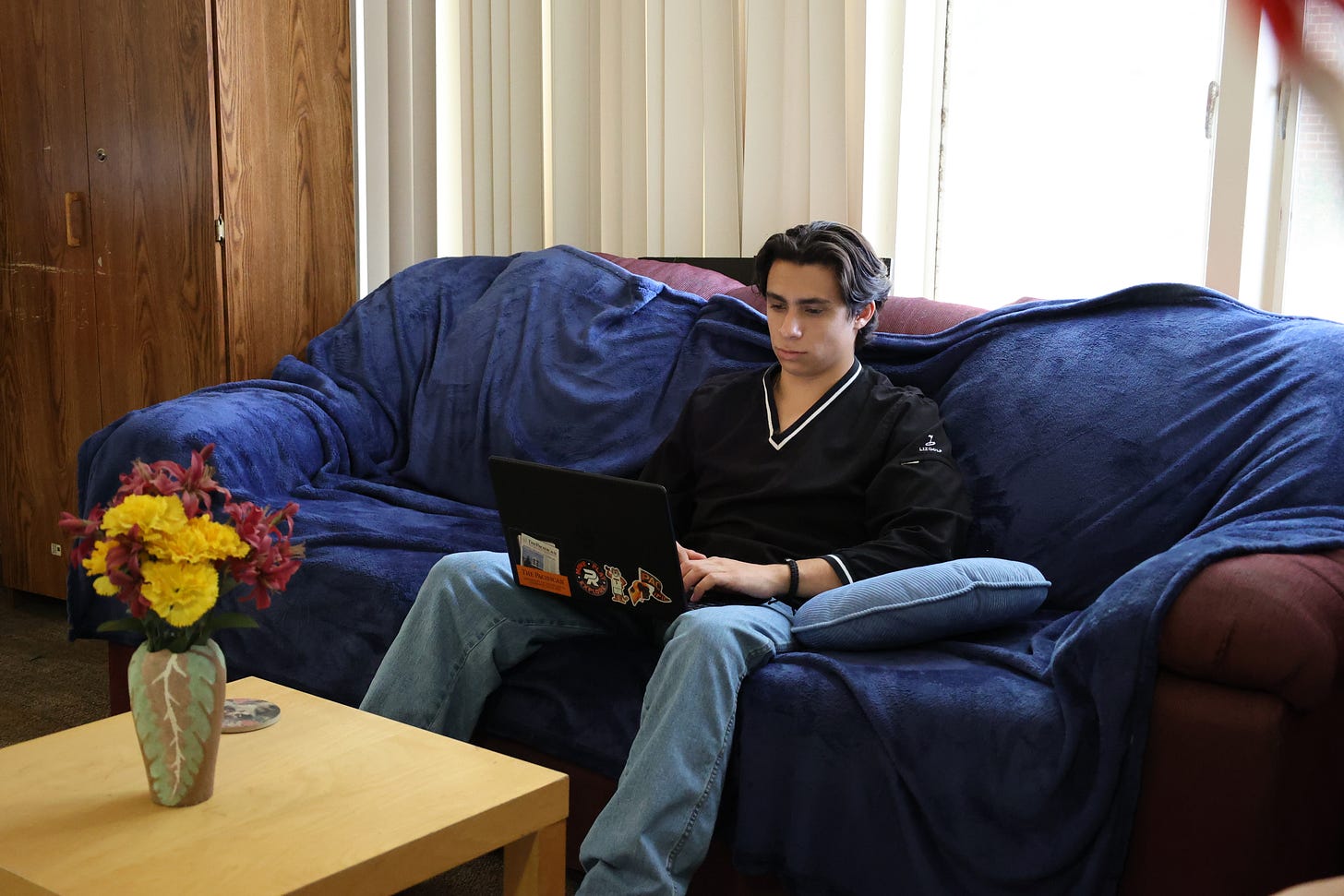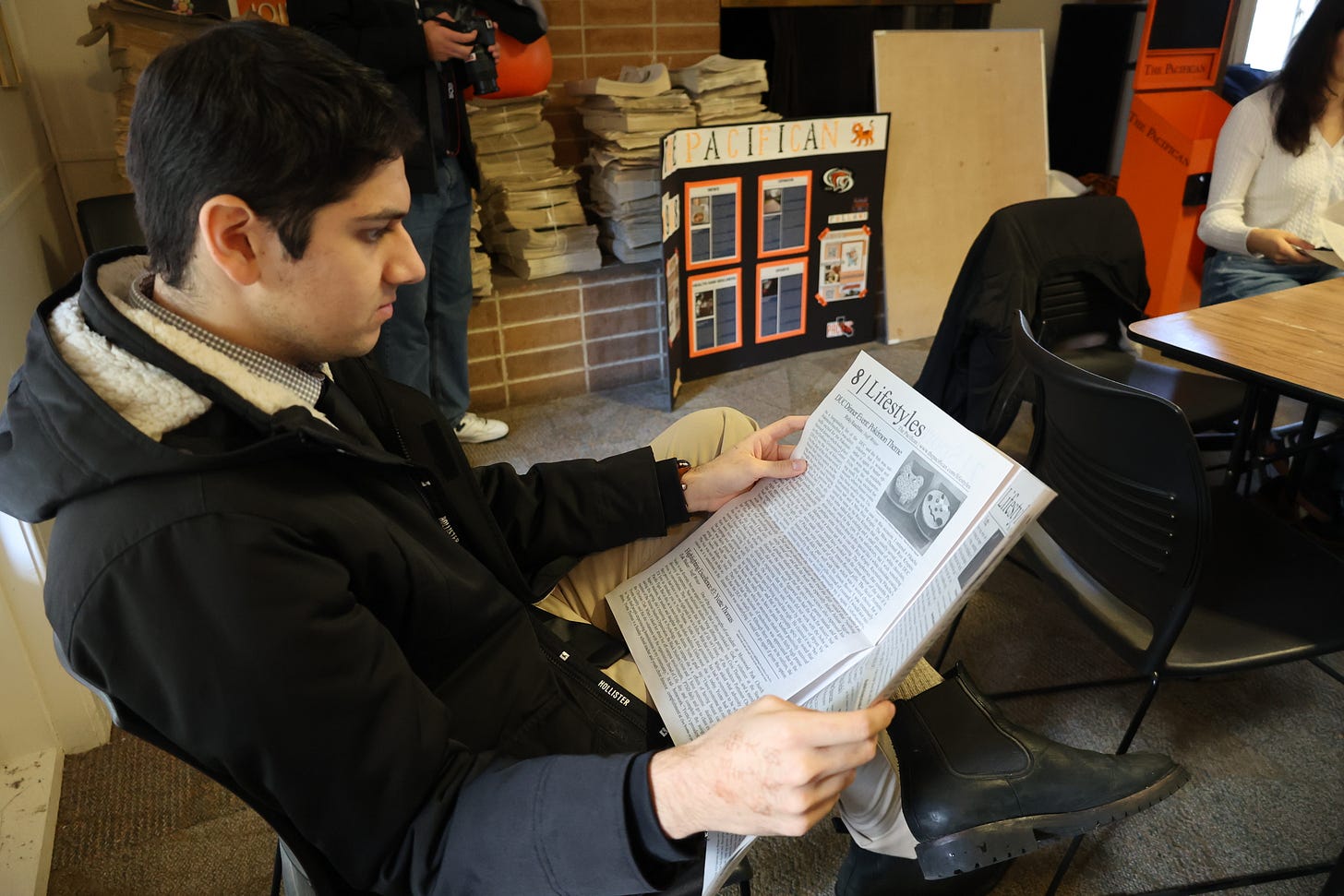Funding cut forces a small California college paper to rebuild — for the better
Like many student newsrooms, The Pacifican adapts to financial strain with new focus

When the usual $20,000-$22,000 budget for The Pacifican, a student-run news outlet at the University of the Pacific, dropped to zero last spring, the editor-in-chief, business manager and faculty advisor all stepped down.
At that point, only seven staff members remained at the outlet, which had been struggling since the COVID-19 pandemic.
It was “a perfect storm,” as current Co-Editor-in-Chief Amaya Leiby put it.
But that storm became the catalyst for a revival.
The remaining staff members focused on rebuilding the outlet from the ground up, finding new revenue sources and reassessing its products with the goal of creating a more sustainable and autonomous organization — one that still serves the university community.
Less than a year later, the staff has grown to 21 members, journalism production has become more consistent, and the new newsletter has received positive feedback from readers.
“We were literally at rock bottom at that point at the end of spring semester,” said Kara Uchizono, a co-editor-in-chief. “We just had almost infinite room for growth but we had to completely start over with no funding.”
This push for financial independence reflects a broader trend among student-run news organizations nationwide, many of which are grappling with declining print readership, a more competitive advertising landscape and funding cuts from their institutions.
At The Pacifican, operations were previously subsidized by a 41-cent student fee overseen by the student government. The publication had its own dedicated budget line as an independent organization, but that was slashed last spring.
Since then, the outlet has relied on two main sources of income: crowdfunding donations and digital advertising revenues. The crowdfunding campaign raised $8,000, which covered expenses for the fall 2024 semester.
Mario Gutierrez, The Pacifican’s business manager, leads the advertising efforts, reaching out to local businesses and offering ad packages ranging from $60 to $275 per month, depending on size, according to the website.
However, Gutierrez said advertising is not yet the outlet’s primary source of income, as it is still in its early stages.
“We're definitely pouring our hearts and stalls into our paper and as with like any sort of business to keep up and to run,” he said. “That is definitely a requirement.”
Limited staffing and financial uncertainty
Staffing remains a significant challenge for the outlet’s expansion, Leiby said. The team had hoped to hire an assistant or a business intern to help Gutierrez, but funding constraints have made that impossible.
Because the current funding can’t pay for all five paid staff members on a full-time basis, hours have to be capped. Gutierrez, for example, can only be paid just 8 hours a week during the school year.
“When you’re trying to increase your revenue so substantially so quickly, that’s just not enough time to do it,” Leiby said. “So he works a ton of hours and doesn’t get paid for them.”
Relying on donations also presents challenges, as the staff is uncertain how much money they can generate. Uchizono said the team must remain flexible with its plans.
She pointed to a plan to publish two print issues each semester, but the funding simply wasn’t available.
“We just have to make all these plans and then re-evaluate … and potentially shelve those, so it’s very hard to be able to put things in motion,” she said.
Zooming out
The Pacifican’s struggles are not unique.
A 2024 study from the Penn State Daily Collegian Alumni Interest Group highlighted the financial and operational struggles of college news organizations nationwide, according to Editor & Publisher’s report. Among the key findings:
Declining readership: Only 8% of students read print, 18% read online editions.
Average annual revenues dropped 58%, with ad revenues falling 73%.
Donations and alumni contributions fell from $5.2 million to $3.7 million between 2020 and 2022.
Many college newsrooms receive little to no support from universities, forcing them to seek alternative funding sources.
A blueprint for success includes a shift in mindset from being the “old student newspaper” to the “campus center of digital media innovation.”
A shift in priorities
The funding cuts at The Pacifican sparked a reevaluation that ultimately boosted readership by more than double and led to a more consistent publication schedule.
After the pandemic, editor Uchizono said the newspaper’s operations began to falter, with increased staff turnover and fewer articles being published.
“You’d probably have like four articles coming out all at once and then you wouldn’t have anything for months, and then there would be like one random article coming out,” she explained.
However, when funding was cut, Leiby said it reignited passion among the remaining staff, renewing their commitment to the paper's century-long legacy. Both editors wanted to leave the publication in a more stable place before graduation.
The team focused on raising revenue, minimizing staff burnout and increasing readership. They cut the podcast, YouTube channel and health and wellness section but introduced a Mailchimp newsletter in response to community needs.
Uchizono mentioned that many faculty and staff found the website difficult to navigate. The new newsletter addressed these concerns, earning the team positive feedback.
“For a long time, nobody even realized that we were still active, unfortunately,” Leiby said.
The editorial team also streamlined operations, narrowing the paper’s focus and reducing sections to improve content quality and consistency.
The paper now publishes a story or two in each of the four sections each week — more than before the funding cut.
The website maintained close to 2,500 visits in November and December, compared to 1,181 in March before the cut, according to Social Media Manager Megan Silva.
Next chapter
Looking ahead, both editors are focused on expanding the paper’s reach.
Leiby envisions the return of a print edition, albeit limited to one or two copies per semester, to preserve tradition.
She’s also exploring professional development opportunities, including media conferences for staff writers, as part of her long-term vision.
For Uchizono, the success of the revitalized Pacifican comes down to community.
“We couldn't have done it without all of our staff writers, our wonderful communications media director who filmed and edited the video (for the crowdfunding campaign) and the sense of community we've created through our love of student-led publications and journalism,” she said.
💬 I want to hear from you! How is your publication adapting to shrinking resources? Email me at nutgrafnews@gmail.com.
Story Spotlight:
🔥Check out coverage of the Los Angeles fires by these student outlets!
Mustang News reported a close friend of a Cal Poly student had her house and her entire neighborhood burned down like “her entire childhood is gone.”
The Pearl Post called on its high school administrators to dismiss students sooner. Despite being in between the Palisades and the Hurst fires, “we, and many other schools, were deemed ‘unaffected’ despite the blooming clouds of smoke in the sky.”
The Van Nuys Mirror published a round-up of what had happened so far including the damages, the firefighting efforts, how the high school students feel about their administration’s reactions and the underfunding of the city’s fire department.
The Corsair photojournalists captured the fire scenes in the Pacific Palisades neighborhood of the city. Really great pictures, I must say.
🔇 Here’s how The Independent Florida Alligator dealt with “no comment” from Nebraska’s Republican U.S. senator-turned-UF president, Ben Sasse. Once named president, he all but cut off communication with the student newspaper.
🤐 The Michigan Daily’s editorial board wrote that the attack on student journalism was “the attack on free speech no one is talking about,” pointing to The Mercury incident and others during last year’s campus protests.
For the record — The Nutgraf talks about these.
✍️ A former student journalist in Louisiana opined in a column that “it could be revolutionary” if young journalists, adept in navigating the digital world, have the opportunity to offer perspectives in the industry that “isn’t as nearly as welcoming as other fields.”
Featured Opportunities:
The Barbed Wire in Texas is looking for a trending news fellow. Apply before Jan. 15.
An immigration reporter is hosting a webinar to prepare journalists to cover immigration under the incoming presidency Jan. 16.
The Grist Fellowship Program accepts applications from early-career journalists until Jan. 21.
WLRN, an NPR station in Miami, is seeking interns for the summer. Apply before Jan. 27.
The Emerging Voices Fellowship by Pen America accepts applications until Jan. 31.
Applications for internships at Newsday close Jan. 31.
The SPJ Mark of Excellence Awards, honoring the best in student journalism, now accepts entries until Feb. 4.
Her Campus Media is expanding its lifestyle and news team for the National Writer Program. More information is here.










